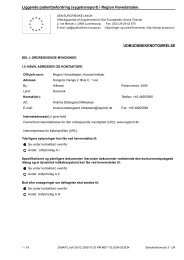Territorial Review Copenhagen - Region Hovedstaden
Territorial Review Copenhagen - Region Hovedstaden
Territorial Review Copenhagen - Region Hovedstaden
Create successful ePaper yourself
Turn your PDF publications into a flip-book with our unique Google optimized e-Paper software.
125<br />
fair list of actions to be taken, but it is not always clear what the urgent<br />
priorities are. They are comprehensive, in that they mention all the elements<br />
that could possibly bring their vision closer, but are not necessarily holistic.<br />
Although ―you can have it both‖ might express neatly the sentiment of many<br />
people in <strong>Copenhagen</strong> and could be a viable strategy to combine several<br />
policy aims, there are policy trade-offs in certain areas. One of these tradeoffs<br />
is maintaining a welfare state (with correspondingly high taxes), versus<br />
fostering a more entrepreneurial city (and country). In many cases, these<br />
trade-offs are slightly more subtle, in that the accumulation of policy goals<br />
may dilute political attention and funds from the key determinants of<br />
<strong>Copenhagen</strong>‘s competitiveness, such as the attraction of highly skilled<br />
labour. Becoming the environmental capital of Europe, for example, may be<br />
a laudable goal, but its relevance for attracting highly skilled foreign labour<br />
will be limited. Recent campaigns to attract international businesses and<br />
tourists do not preclude the attraction of highly skilled foreign labour, but<br />
they can be of only modest importance if they are not explicitly and<br />
simultaneously geared towards that goal. Stimulating creative sectors in<br />
<strong>Copenhagen</strong> may be a way to make <strong>Copenhagen</strong> more attractive, but it is not<br />
clear that the stimulation package has been designed with the demands of<br />
highly skilled foreign labour in mind. Finally, although the overall visions<br />
formulated are ambitious in scope, they are less far-reaching in their actual<br />
targets. A global instead of a European benchmark might have expressed<br />
more vision.<br />
A key challenge for <strong>Copenhagen</strong> is the shortage of highly skilled labour,<br />
as was argued in Chapter 1. Although this is mentioned in the different<br />
strategies, it is not clearly identified as the force that should drive the<br />
region‘s main initiatives. As mentioned above, strategies for solving the<br />
shortage of skilled labour should focus on making better use of the current<br />
population, such as getting students to work earlier, making better use of<br />
immigrants‘ capabilities, but also by attracting highly skilled foreigners.<br />
Competition for these highly skilled foreigners is intense and can be<br />
considered global. The ambition to be the most attractive metropolis in<br />
Northern Europe is somewhat modest, considering the global scale of flows<br />
of highly skilled labour. The strategic visions do not explicitly celebrate the<br />
innovative effects of cultural diversity, as for example Toronto has done in<br />
its economic competitiveness strategy. The following sections will focus on<br />
the main sectoral issues mentioned in these strategies, in order to assess the<br />
implementation of the strategies for the metropolitan area.

















